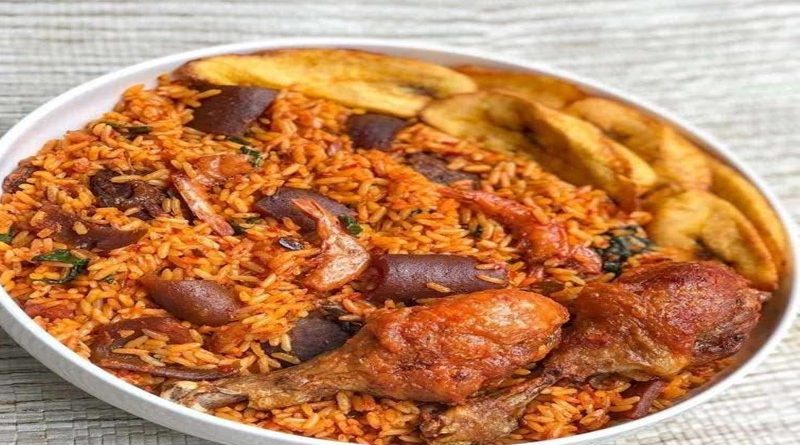Sierra Leone beats Ghana and Nigeria to win 2019 Jollof Rice Competition
Sierra Leone has won the 2019 Jollof Rice Competition held in Washington, District of Columbia (DC), USA.
The West African country beat off stiff competition from neighbouring nations Liberia, Nigeria and Ghana.

© Provided by Genesis Media Sierra Leone beats Ghana to win 2019 Jollof Competition in US
Ghana could only manage fourth position, behind Liberia and Nigeria who emerged second and third, respectively.
Sierra Leone was represented in the Jollof Rice Competition by Carol Mabinty Khanu, a 26-year-old chef.
The competition was hosted at the Pupils Heart at the College of the District of Columbia (UDC) on July 6.
The festival was organised by Afrooilitan Insights, which is founded by one Ishmael Osekre.
“We are incredibly joyful for Carol and we desire her and all other winners and individuals the greatest on their individual journeys, they all immensely contributed to the achievements tale that this festival has developed into given that we began in 2017,“ Mr. Osekre told TheAfricanDream.net.
The first-ever Jollof Rice competition held in Washington DC was in 2017.and was eventually won by Nigeria.
Jollof rice remains one of the most common dishes in Western Africa, consumed throughout the regions of Nigeria, Senegal, Ghana, Sierra Leone, Gambia, Togo, Liberia, Niger, Mali, Ivory Coast and Cameroon.
In recent years, there has been constant debates between Ghanaians and Nigerians over which country served the best jollof.
Rice is eaten around the world but different countries consume it differently. Each country has made the grain their own, with original recipes and distinct spices. Here is a look at some of the most popular rice dishes consumed around the world.
Nasi goreng (Indonesia)
This simple-but-delicious dish consists of stir-fried rice with vegetables and a selection of meats (usually chicken or prawns), garnished with sweet soy sauce, shallot, garlic, tamarind and chili. For an extra-special treat, you can add a fried egg on top of the finished plate of food. A staple of the local cuisine, nasi goreng can be enjoyed everywhere – from street-food stalls to high-end restaurants.
Risotto (Italy)
The Italians didn’t just give the world pastas and pizzas – they also gave us the risotto. Made (almost by accident, according to one of its origin stories) in northern Italy, this is a rice-based dish cooked to an almost creamy consistency; the broth can be made with either meat, fish or vegetables. Most risottos also contain butter, onion, white wine and, of course, a generous helping of Parmesan.
Jollof rice (West Africa)
A popular dish in many West African countries, Jollof rice is often consumed during special ceremonies like weddings and birthdays. Although there are regional variations (in name and ingredients), most Jollof dishes are made by cooking the rice in a tomato- and onion-based sauce with spices like nutmeg, ginger and cumin, and served with a helping of mutton (goat meat) or beef.
Tahdig (Iran)
A specialty of Iranian cuisine, tahdig translates to “bottom of the pot” in Persian and refers to the crisped crumbs at the bottom of a pot of cooked rice. This may sound unappetizing but a bed of the rice with saffron-flavored yogurt, potatoes and tomatoes (with a piece of bread as an accompaniment) makes for a delicious dish.
Mansaf (Jordan)
The national dish of Jordan (it is also popular in Palestine, Iraq, Syria and Saudi Arabia), the first examples of mansaf were reportedly a serving of meat (camel or lamb) cooked in clarified butter and served with bread. Rice was introduced to the dish in the early decades of the 20th century. Today, it is served on top of a bed of white rice and sometimes with bulgur (cereal food made from several wheat species).
Jambalaya (Louisiana, US)
An excellent example of the multicultural melting pot that birthed the U.S., jambalaya is a dish of Spanish and French descent prepared with meat, vegetables and rice. More traditional versions can also include sausages and other kinds of meat or seafood. The vegetables used include celery, onion and green bell pepper; tomatoes are not part of the variation made in southwestern and south-central Louisiana.
Champorado (Philippines)
From the U.S. we travel to the Philippines for a taste of champorado – a chocolate rice porridge. Made by boiling sticky rice and cocoa powder (with milk and sugar to make it sweeter), this is a popular snack in the southeast Asian country. Sometimes also served with salty dried fish chips, it can also be made with coffee powder instead of the cocoa.9/16 SLIDES© from_my_point_of_view/Getty Images
Paella (Spain)
Now a worldwide favorite, paellas came to us from the Valencia region of Spain. A symbol of that region’s identity, proper paella is believed to be that which is cooked in olive oil and consists of white (round grain) rice, green beans, meat (preferably chicken or rabbit) and snails, with saffron and rosemary for seasoning. Other types of paella can include vegetables and seafood.
Hokkien fried rice (China)
Also called Fujian fried rice, this is a popular dish at many Chinese restaurants. As simple as it is delicious, it consists of a thick sauce poured over a bowl of fried rice with pieces of egg, mushrooms, meat (or prawns) and vegetables. For that authentic touch, you could also add winter bamboo shoots and peanut oil to your list of ingredients.
Biryani (India)
An iconic Indian dish that has found fans in culinary traditions around the world, there are many stories behind the origin of the biryani. However, no matter who (or where) it was created, biryani is usually made with lamb or chicken (marinated overnight) cooked with yogurt, herbs, spices and dried fruits in a clay oven and served with steamed rice. A similar rice-based dish from India is pulao (or pilaf); this is prepared slightly differently, in that it is less moist and lacks the spices.
Katsudon (Japan)
A popular Japanese dish served as a deep-fried pork cutlet, egg and vegetables on a bed of rice with a sweet-savory sauce, it is now traditional for Japanese students to eat a helping of this before taking exams! 13/16 SLIDES© Westend61/Getty Images
Bibimbap (Korea)
Literally translated as “mixed rice,” this dish is served as a bowl of warm white rice topped with sauteed vegetables and garnished with chili pepper paste and soy sauce. Common additions include egg (fried or raw) and meat (usually beef). Although the items are served separately, remember to mix the ingredients together before eating!
Pabellón criollo (Venezuela)
A traditional Venezuelan dish, this popular food item is a variation of the rice and beans combination. It is basically a plate of rice served with a side of stewed black beans and a bowl of shredded beef stew. They may also be served with tajadas (fried plantain slices) and/or a fried egg.
Kedgeree (England)
Another example of the Colonial-era led fusion between England and India, kedgeree (called kitchdi in the latter country) started life as a bean- or lentil-based rice dish served with yogurt. When it was transported to the U.K., flaked fish (smoked haddock or salmon), parsley and hard-boiled eggs were added to the list of ingredients. Either way, it is garnished with specially designed and dry-toasted spice mixtures.
Xôi ngũ sắc (Vietnam)
A popular rice dish in Vietnam, you’d be forgiven for thinking it was created in the kitchens of high-end restaurants. In reality, though, this rainbow-colored dish is eaten in the rural parts of the country and contains (properly made) absolutely no food coloring. Instead, the rice is cooked with a selection of natural ingredients like the magenta plant, pandan leaf, gấc fruit and mung beans.




